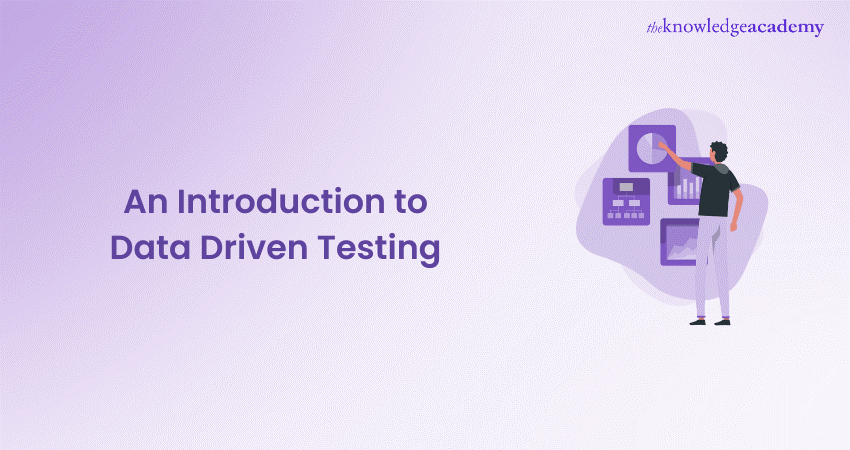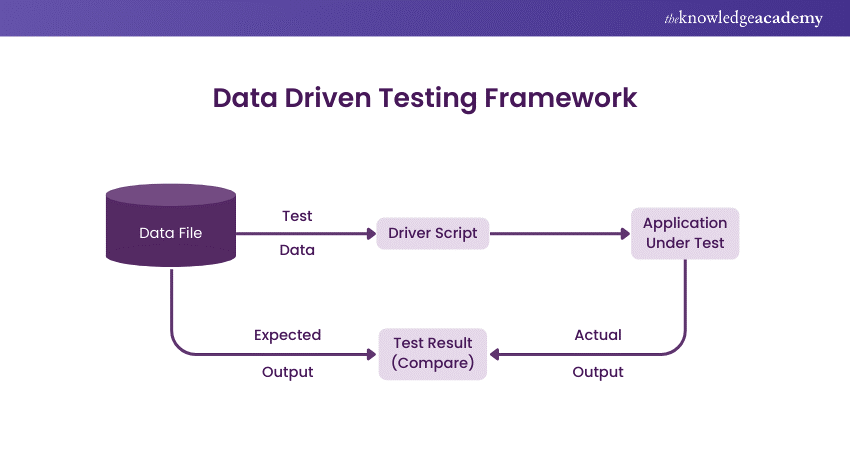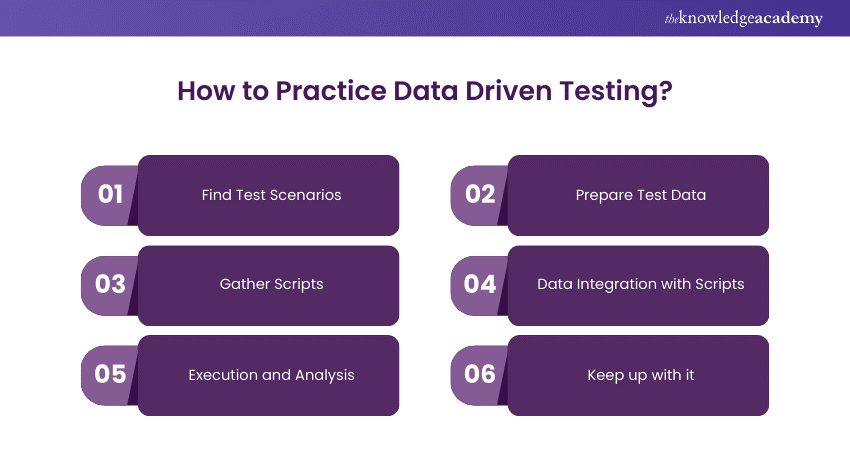We may not have the course you’re looking for. If you enquire or give us a call on 01344203999 and speak to our training experts, we may still be able to help with your training requirements.
We ensure quality, budget-alignment, and timely delivery by our expert instructors.

Are you tired of manual testing that's time-consuming and prone to human error? Imagine a testing process that's automated, reliable, and provides valuable insights into your application's quality. Data-Driven Testing is the solution you've been looking for. By leveraging Data-Driven Testing, you can significantly improve your testing efficiency and effectiveness.
Ready to embrace the power of Data-Driven Testing? Let's explore how this innovative approach can revolutionise your testing process and deliver higher-quality software.
Table of Contents
1) What is Data Driven Testing?
2) How Does Data Driven Testing Work?
3) How to Practice Data Driven Testing?
4) Advantages of Data Driven Testing
5) Disadvantages of Data Driven Testing
6) Real-World Applications of Data-Driven Testing
7) Difference Between Data-Driven Tests and Keyword-Driven Tests
8) Conclusion
What is Data Driven Testing?
Data Driven Testing is a Type of Framework in which for Test Design and Execution Process all the data needed is read from input files. Rather than writing multiple test cases for all input scenarios, one testcase will be written and data is supplied externally via Excel sheets or CSV files or DB tables etc. This method of testing helps to validate a software application against wide range inputs, making it more stable and accurate in different conditions.

Data-Driven Testing basically means to separate test logic from the data you are feeding into that script, which allows us to use the same script with different sets of inputs. What this also does is divide-and-conquer, so the time taken to test decreases and there are less errors in testing due to its manual nature. The most common use case is in scenarios where the application must consider different combinations of input — form submission, login credentials, or data for a transaction.
How Does Data Driven Testing Work?
Data-Driven Testing: DDT works through driving the execution of tests using a set of input data and validating that outputs are what we expect. Data-Driven Testing consists of below key components
a) Test Scripts: These are the automation scripts which carry out the logic of a Test Case. The scripts will expect inputs from External Data Sources.
b) Sources: How/where the data in tests is stored externally, typically like Excel, CSV or databases and XML stand forked. It contains the data that is needed as input for testing and what results can be expected at outputs.
c) Test Frameworks: Some of the common test frameworks used in Data-Driven Testing are Selenium, JUnit, TestNG etc. These are helpful in reading data from any external sources and then executing the test scripts based on it.
d) Test Execution: During execution, framework read the data from external source and pass it to Test Scripts. The scripts work with the inputs you feed them, then check if those algorithms match a known result (expected) to determine if that test has passed/failed.
Transform your data analytics prowess with Google Analytics Certification!
How to Practice Data Driven Testing?
To start with Data-Driven Testing follow below steps:

a) Find Test Scenarios: Figure out which test scenarios can be achieved from Data-Driven Testing. Find Cases with Repeated Steps & Variable Data inputs
b) Prepare Test Data: Develop data sets which consist necessary inputs and expected results. Keep these in external locations such as spreadsheets, CSV folders or databases.
c) Gather Scripts: Create scripts that can fetch external data. Utilise some testing framework where you can perform data-driven approach (eg- Selenium + TestNG/JUnit )
d) Data Integration with Scripts: Change your test scripts to read data from external sources. It would require wiring the test framework to get data and looping through each dataset during the execution of a specific suite.
e) Execution and Analysis: Execute the test scripts with the data sets, analyse their results. Ensure that there are no differences between the actual and expected results and refine your test data or scripts accordingly.
f) Keep up with it: Get in the habit of keeping your data sets and trough-ware current as the application changes. Because of the inherent design, it is easy to add new test cases in raining day by only updating some data files and making no adjustment on also a piece of testing logic.
Harness data to optimise marketing with Data Analytics for Marketing Professional Course!
Advantages of Data Driven Testing
Here are some key benefits of Data-Driven Testing:
a) Set of Test Data: Automation framework allows you to perform testing on the set of test data and these tests can be run with different sets. This helps in reducing repeated carries across dedicated test cases which will save time.
b) Efficiency: The availability of automating the repetitive tests with different inputs through automation sometimes guarantees faster and more efficient testing.
c) Maintainability: Test data is maintained independently of test logic which makes tests easy to update and maintain.
d) More Exhaustive Coverage: It allows you to test over a wider range of scenarios because multiple data sets are tested which means better coverage and more reliable tests.
e) Scalable: New test cases can be added as the application scales simply by expanding their data sets, with no modifications to central parts of the test scripts.
Disadvantages of Data Driven Testing
Cons of Data-Driven Testing though it has benefits:
a) Complexity in Setup: The set up can be challenging, especially if you are an amateur and the need of integrating external data sources with test scripts.
b) Data Management: Data can be big and thus needs careful organisation, managing them alone is a task.
c) Tool Dependence: Efficient Data-Driven Testing Tool mostly work on tools and frameworks that needs a new learning or license cost too.
d) Problem solving difficulties: Debugging in Data Driven Testing is more difficult as the issue can be at any of its levels, such as Test script may fail or data source among others.
Analyse, optimise, dominate markets with Marketing Analytics Training – register today!
Real-World Applications of Data-Driven Testing
Data Driven Testing is an approach to validate the application under test using multiple sets of data. This can be applied where ever DDT fits in (such as Compliance Validation, Edge case scenarios) across several industries. Here are two examples:
Example 1: Loan Application System
In a loan application, there are many such input fields — applicant income, credit score (risk level), loan amount and repayment terms. With the help of Data-Driven Testing, testers can test a number of combinations for input and evaluate how well this system calculates loan eligibility (and repayment schedules) to various applicants.
Example 2: Patient Database
For example, in healthcare applications patient management systems will need to process & store a multitude of data elements like Patient Demographics and their medical history and treatment plans. Data-Driven Testing can be used to ascertain whether this information is read, written and stored by the system accurately, test how different data types are handled and that correct outputs for patient admissions/ discharge / billing etc. are produced under variety of circumstances.
Difference Between Data-Driven Tests and Keyword-Driven Tests
Although both Data-Driven and Keyword-Driven Testing is intended to help test automation, they have different approaches:
Data-Driven Testing ideally for keeping the same test logic but different data inputs. The main goal is to test the application with one or more data sets, and see if it validates.
What Is Keyword-Driven Testing? These keywords drive the test logic which makes tests more modular and readable. It enables even a layman to generate test case using set of keywords without going about the code in behind.
Boost ROI with Social Analytics Training- kickstart your career now!
Conclusion
Data-Driven Testing is a powerful approach for validating software applications across a wide range of input scenarios. By separating test data from test scripts, this method enhances reusability, maintainability, and test coverage. While it requires careful setup and data management, the benefits of improved efficiency and comprehensive testing make it a valuable practice for testers.
Frequently Asked Questions

Data-driven API testing involves testing APIs with various data sets to ensure they respond correctly to different inputs. This method verifies that APIs handle all expected scenarios, including edge cases, by feeding different data inputs during testing.

Yes, Data-Driven Testing can be automated using test automation frameworks like Selenium, TestNG, JUnit, and others. These frameworks support reading data from external sources and executing test scripts automatically, improving efficiency and reducing manual effort.

Data-Driven Testing is achieved using test automation tools and frameworks that support external data integration. The test scripts are designed to read input values from data sources like Excel, CSV files, or databases, allowing the same script to be executed with different data sets.

The Knowledge Academy takes global learning to new heights, offering over 30,000 online courses across 490+ locations in 220 countries. This expansive reach ensures accessibility and convenience for learners worldwide.
Alongside our diverse Online Course Catalogue, encompassing 19 major categories, we go the extra mile by providing a plethora of free educational Online Resources like News updates, Blogs, videos, webinars, and interview questions. Tailoring learning experiences further, professionals can maximise value with customisable Course Bundles of TKA.

The Knowledge Academy’s Knowledge Pass, a prepaid voucher, adds another layer of flexibility, allowing course bookings over a 12-month period. Join us on a journey where education knows no bounds.

The Knowledge Academy offers various Digital Marketing Courses, including the Data Driven Marketing Course, Google Analytics Certification, and Social Media Analytics Course. These courses cater to different skill levels, providing comprehensive insights into Benefits of Web Analytics.
Our Digital Marketing Blogs cover a range of topics related to SEO, content creation, social media strategies, and analytics, offering valuable resources, best practices, and industry insights. Whether you are a beginner or looking to advance your digital marketing skills, The Knowledge Academy's diverse courses and informative blogs have got you covered.
Upcoming Digital Marketing Resources Batches & Dates
Date
 Data-Driven Marketing Course
Data-Driven Marketing Course
Fri 28th Feb 2025
Fri 4th Apr 2025
Fri 27th Jun 2025
Fri 29th Aug 2025
Fri 24th Oct 2025
Fri 5th Dec 2025







 Top Rated Course
Top Rated Course



 If you wish to make any changes to your course, please
If you wish to make any changes to your course, please


